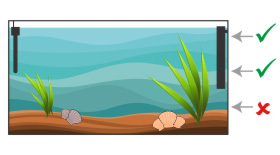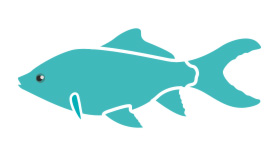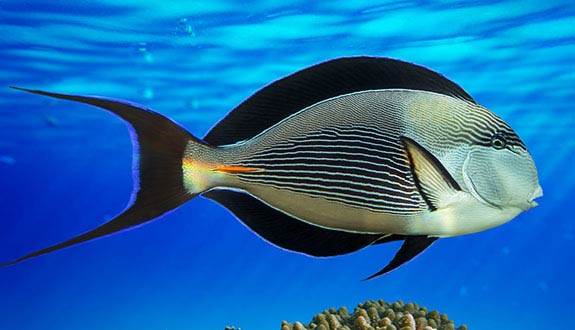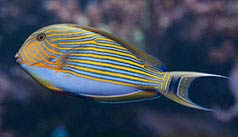

Alternative species (click on the thumbnail to see the card)
Names
Scientific name
Acanthurus sohal
Acanthurus carinatus
Aspisurus sohar
Chaetodon sohal
Chaetodon sohar
Choetodon sohab
Acanthurus ruppelii
Ctenodon ruppelii
Common name
Sohal tang
Sohal surgeonfish
Red Sea surgeonfish
Origin

Origin: Red Sea, Gulf of Aden
Natural habitat: it frequents shallow coral reefs. It likes the Acropora flats under which it can take refuge in case of danger.
Dimorphism

None
Group

Acanthuridae
Volume

1,200 L / 264 imp gal / 317 US gal
Parameters

T°: 24 to 30°C or 75 to 86°F
pH: 7.5 to 8.5
Density: 1021 to 1028
Difficulty

Hard
Size

25 cm (10")
Longevity

15 to 40 years
Living zone

Middle and top
Individuals

1
Food
How to feed the Sohal tang?
Food
How to feed the Sohal tang?
Like all its cousins, the Acanthurus sohal is a mainly vegetarian fish. In the wild, it continually grazes on green algae but does not mind a few small prey that it finds while digging in the ground.
In aquariums, you will have to imitate this type of diet by offering your fish mainly vegetarian food, such as seaweed (Sargasso, Caulerpes, Ulves, Spirulina), salad, peas, broccoli or spinach (previously boiled). Artemia, worms, mussel pieces and commercially available dry food are also appreciated after the acclimatization period.
Distribute at least 2 to 3 large meals a day to satisfy the appetite of this energetic giant.
Behavior
What kind of behavior does the Sohal tang have?
Behavior
What kind of behavior does the Sohal tang have?
This fish is a great swimmer, very fast, very agitated (even nervous) always looking for food. It needs large swimming areas to express all this energy./p>
Very territorial, aggressive and dominant, it fiercely defends its zone of life. In the wild, it even attacks fish twice its size, such as triggerfish or parrotfish.
Cohabitation
Who can live with the Sohal tang?
Cohabitation
Who can live with the Sohal tang
Given its aggressive and aggressive temperament, the Acanthurus sohal's good understanding with its roommates is one of the black spots of its captive maintenance. It does not tolerate: members of its species, other surgeon-fish (except those of different size and shape such as Z. flavescens), fish whose coat is close to its own, territorial fish, newcomers. On the other hand, it is more tolerant with non-territorial fish but beware of the strong food competition to which they may be subjected because of this voracious. Of course, you will introduce the Acanthurus last in your aquarium for more chance of success.
Corals are safe, however, because it rarely attacks them. If your Acanthurus starts to bite them, it's hungry! There is too much time between two feedings: revise the rhythm of the meals to eliminate this behavior.
Breeding
How to breed the Sohal tang?
Breeding
How to breed the Sohal tang?
Unfortunately, it is unlikely that captive breeding will ever be possible. In the wild, the eggs are pelagic and drift with the ocean currents. After their birth, the larvae undergo several transformations before beginning to resemble the adults (from 2 cm / 0.8").
Its aquarium
Which aquarium for the Sohal tang?
Its aquarium
Which aquarium for the Sohal tang?
The first condition of maintenance is of course the size of the aquarium, which must be at least 1,200 L / 264 Imp Gal / 317 US Gal at the strict minimum to properly accommodate this imposing sportsman.
A reef aquarium will be ideal for this Surgeon: the water is clean and well oxygenated, the current is strong and the intense lighting allows the growth of the algae he feeds on. Moreover, it is preferable to introduce it in a tank richly planted with green algae. Don't worry, it generally does not touch the corals!
To reassure this nervous fish, plan many hiding places, holes and interstices when you install your rocks. Your Acanthurus will be able to shelter in case of fright.
Leave plenty of space for swimming.
Good To know
Find all additional information!
Good To know
Find all additional information!
Considering its temperament and size (in our aquariums, its size rarely exceeds 25 cm (10") but in the wild, it can measure up to 50 cm / 20"!), the question is legitimate: does it really have its place in our aquariums? Anyway, it is a species reserved for experienced aquarists with a very large aquarium.
Acclimatization can be a little tricky but this Surgeon is quite solid. After this period, it is easy to maintain and it is quite resistant to diseases (as long as the maintenance of the aquarium is well done).
It is rather difficult to find it in the trade, but finally, considering its difficulty of maintenance, it is not an evil...
The Sohal tang has a sharp and probably venomous scalpel at the base of the caudal, hence its name "surgeon fish". You have been warned!
Yours photos!
Comments
Sort by:
Please login to post comments


